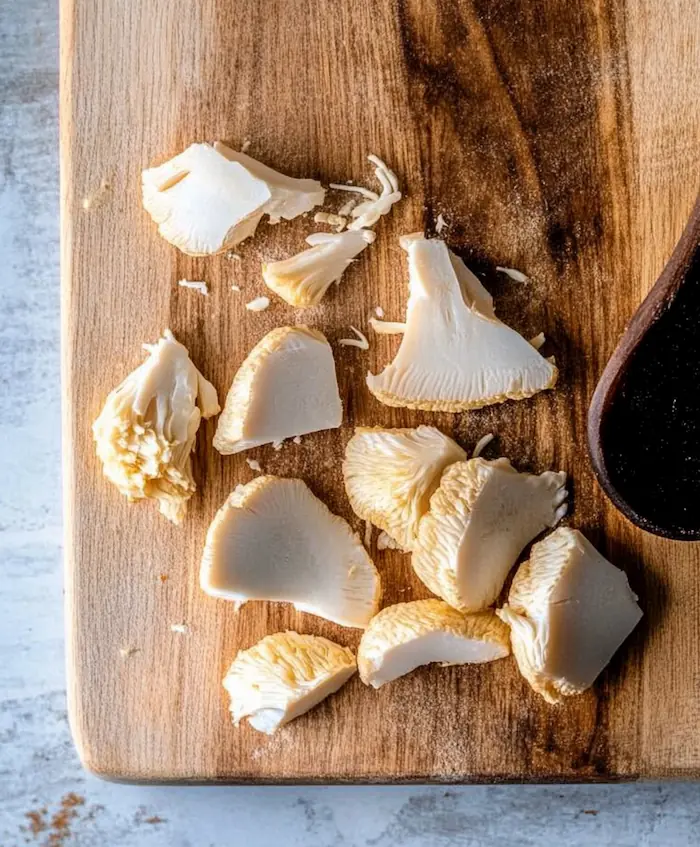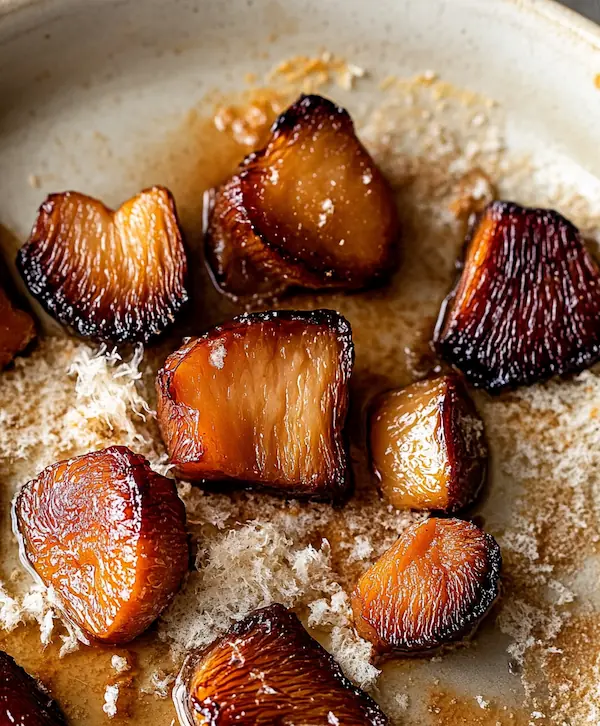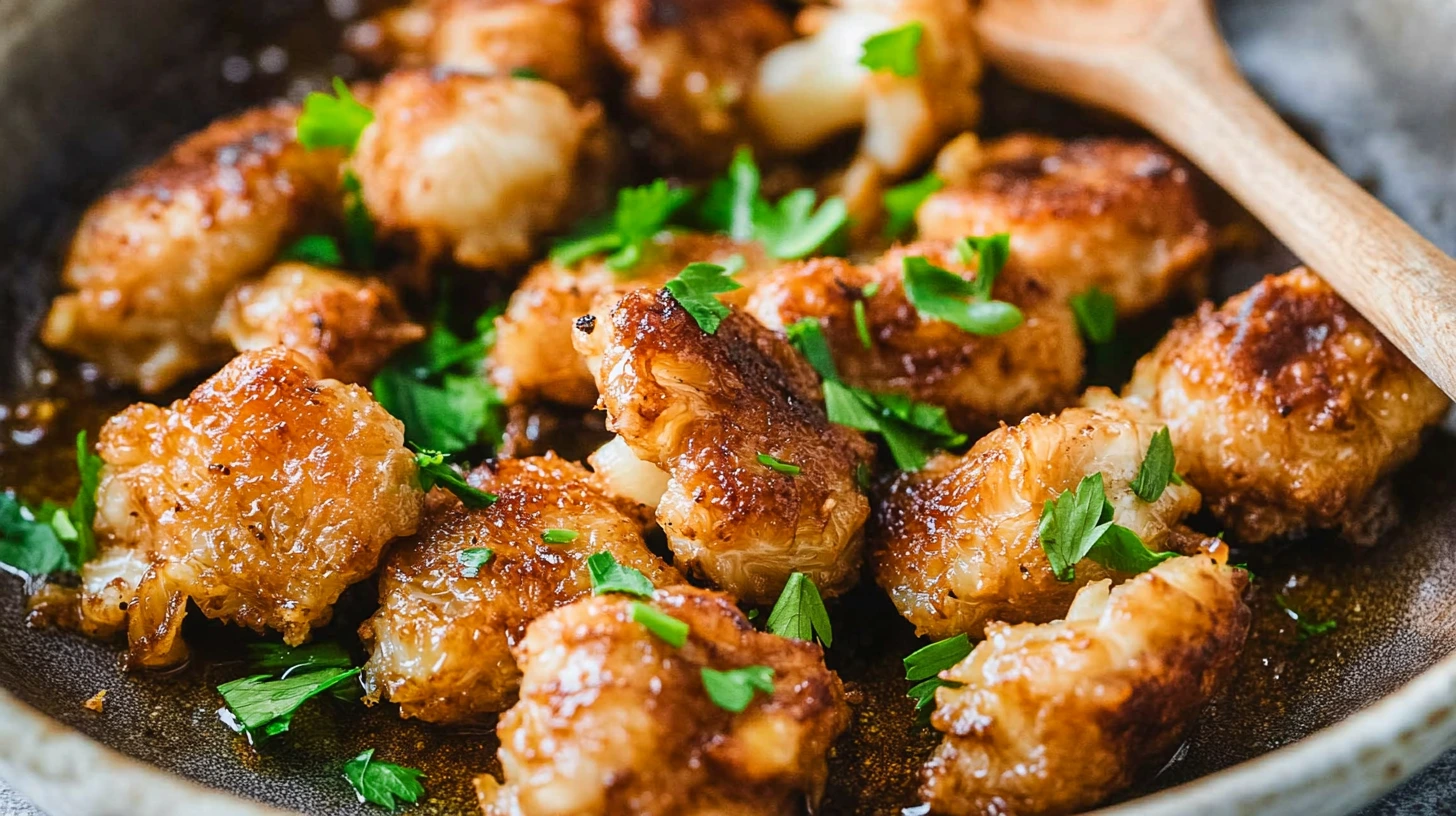Lion’s Mane mushrooms are not only a culinary delight but also a nutritional powerhouse. This Lion’s Mane mushroom recipe is perfect for showcasing their unique flavor and texture, which resemble seafood like crab or lobster. Whether you’re a seasoned cook or new to this versatile ingredient, this guide will teach you everything from preparation tips to creative ways to enjoy Lion’s Mane mushrooms.
Now the focus keyphrase, “Lion’s Mane mushroom recipe,” is included naturally in the introduction. Let me know if you need further refinements!
Table of contents
Health Benefits of Lion’s Mane Mushrooms
Nutritional Profile
Lion’s Mane mushrooms are a powerhouse of nutrients, making them a valuable addition to any diet. Packed with essential vitamins and minerals, they include:
- Vitamin D: Supports bone health and immunity.
- Potassium: Helps regulate fluid balance and muscle contractions.
- Antioxidants: Combat oxidative stress and inflammation.
- Dietary Fiber: Aids in digestion and promotes gut health.
Low in calories and fat, these mushrooms are an excellent choice for those aiming for a nutrient-dense yet calorie-conscious meal.
Cognitive and Medicinal Benefits
Lion’s Mane mushrooms have long been celebrated in traditional medicine, especially in East Asia, for their cognitive benefits. Modern studies suggest they may:
- Enhance Brain Function: Compounds like hericenones and erinacines promote nerve growth factor (NGF), essential for brain cell regeneration.
- Reduce Symptoms of Depression and Anxiety: By supporting healthy brain function, they may positively impact mood and mental clarity.
- Support Memory and Focus: Their neuroprotective properties are particularly beneficial for aging individuals.
Supporting Digestive Health
These mushrooms contain bioactive compounds that promote the growth of beneficial gut bacteria. Regular consumption may:
- Improve digestion and nutrient absorption.
- Reduce inflammation in the digestive tract.
- Aid in the healing of ulcers and gastrointestinal discomfort.
The combination of taste, versatility, and health benefits makes Lion’s Mane mushrooms a standout ingredient in modern and traditional cuisines alike.
Selecting and Preparing Lion’s Mane Mushrooms
How to Choose Fresh Lion’s Mane Mushrooms
To create a mouthwatering dish, you’ll want to start with fresh, high-quality mushrooms. When selecting Lion’s Mane mushrooms, keep these pointers in mind:
- Look for Vibrant Color: Fresh Lion’s Mane mushrooms should be white or off-white. If they appear brown or shriveled, they are past their prime.
- Check for Firmness: Gently press the mushroom to ensure it feels firm and dense. Soft or spongy spots indicate age or improper storage.
- Smell the Mushrooms: They should have a mild, earthy scent. Avoid mushrooms with any unpleasant or sour odors.
By carefully selecting the freshest mushrooms, you set yourself up for a delightful culinary experience.
Cleaning and Prepping the Mushrooms
Before cooking, it’s essential to clean and prepare Lion’s Mane mushrooms properly. Although they are relatively easy to clean compared to other mushrooms, a few steps will ensure your recipe shines:
- Gently Brush Away Dirt: Use a soft-bristled brush or a damp cloth to remove any visible dirt. Avoid soaking the mushrooms, as they can absorb water and lose their flavor.
- Trim the Base: The base of the mushroom may have tough or woody parts. Use a sharp knife to trim away these sections.
- Cut into Desired Shapes: Depending on your recipe, you can slice the mushrooms into thick medallions or pull them apart into smaller pieces to mimic shredded crab or lobster.
With the mushrooms clean and ready, you’re all set to dive into cooking. Preparing them carefully not only improves the taste but also ensures a perfect texture in every bite.

Lion’s Mane Mushroom Recipe
Ingredients List
To create this delicious recipe, you’ll need a few simple ingredients. With each one chosen carefully, the flavors of the Lion’s Mane mushrooms will truly stand out. Here’s what you’ll need:
- 1 lb Lion’s Mane mushrooms (fresh and cleaned)
- 2 tablespoons olive oil (or butter for added richness)
- 3 garlic cloves (minced)
- 1 teaspoon salt (or to taste)
- ½ teaspoon black pepper
- Juice of 1 lemon (optional, for a refreshing finish)
- Fresh parsley (chopped, for garnish)
These ingredients are easy to find and come together quickly, making this recipe perfect for weeknights or special occasions.
Step-by-Step Cooking Instructions
Let’s walk through the steps to prepare this mouthwatering Lion’s Mane mushroom dish. Follow these directions to ensure a flavorful and satisfying meal:
- Heat the Oil: Start by heating olive oil in a large skillet over medium heat. If you’re using butter, let it melt until it becomes slightly golden and fragrant.
- Cook the Mushrooms: Add the cleaned and sliced mushrooms to the skillet. Stir occasionally, allowing them to cook evenly. As they sauté, you’ll notice their edges becoming golden and crispy.
- Add Garlic: Toss in the minced garlic and cook for an additional 1-2 minutes. The garlic will infuse the mushrooms with a delicious aroma and enhance their natural flavors.
- Season Generously: Sprinkle the salt and black pepper over the mushrooms, adjusting the seasoning to your preference. Stir well to ensure the seasoning is evenly distributed.
- Add Lemon Juice (Optional): For a touch of brightness, squeeze fresh lemon juice over the cooked mushrooms. This step enhances the dish’s overall taste and balances the rich flavors.
- Garnish and Serve: Remove the skillet from heat and sprinkle the dish with chopped parsley. Serve immediately as a standalone dish or a side to complement your main course.
With these easy steps, you’ll have a dish that’s not only nutritious but also bursting with flavor.
Tips for Best Results
- Don’t Overcrowd the Pan: Cooking the mushrooms in a single layer ensures they crisp up instead of steaming.
- Experiment with Spices: Feel free to add smoked paprika, thyme, or chili flakes for extra depth and spice.
- Pair with Sides: Lion’s Mane mushrooms pair wonderfully with fresh greens, quinoa, or crusty bread.
Other Culinary Uses for Lion’s Mane Mushrooms
Lion’s Mane as a Meat Substitute
Lion’s Mane mushrooms are an outstanding choice when looking for a meat alternative, thanks to their tender, fibrous texture that mimics seafood or chicken. With that in mind, let’s explore how they can elevate your meals:
- “Crab” Cakes: First, shred the mushrooms into fine, flaky pieces. Then, mix them with breadcrumbs, fresh herbs, and a simple binder like eggs or flaxseed. Finally, pan-fry them for a golden, crispy treat. This dish not only feels indulgent but also delivers a unique, seafood-inspired flavor.
- Vegan “Lobster” Rolls: Instead of traditional lobster, sauté the mushrooms in butter (or a vegan alternative), garlic, and smoked paprika. Serve them on soft, toasted buns, and you’ll have a dish that’s comforting yet light.
- Hearty Tacos: If you’re craving something spicy, season the mushrooms with cumin, chili powder, and lime juice. Wrap them in warm tortillas for a satisfying taco night.
Because of their adaptability, Lion’s Mane mushrooms can easily replace meat in both classic and innovative recipes.
Additional Cooking Techniques
Although sautéing is one of the simplest methods to prepare Lion’s Mane mushrooms, there are many other ways to bring out their best flavors:
- Roasting: Start by tossing the mushrooms with olive oil, salt, and pepper. Spread them on a baking sheet and roast them at 400°F (200°C) for about 20 minutes. The result is crispy edges and a slightly caramelized taste.
- Grilling: Thick slices of Lion’s Mane mushrooms can be marinated in soy sauce, garlic, and a touch of honey before grilling. This creates a smoky, sweet, and savory bite that pairs wonderfully with summer dishes.
- Stir-Frying: Add sliced mushrooms to a hot wok along with colorful veggies, tofu, and a tangy sauce. Stir-frying preserves their texture and integrates them beautifully into quick meals.
By using these varied cooking techniques, you’ll keep your meals exciting and flavorful every time.
Pairing Lion’s Mane with Other Ingredients
Lion’s Mane mushrooms shine when paired with complementary ingredients. Let’s explore a few winning combinations:
- Fresh Herbs: Adding thyme, parsley, or rosemary enhances their earthy flavor.
- Proteins: They work wonderfully in egg dishes like frittatas or as a side with grilled fish or chicken.
- Grains: For a hearty and balanced dish, serve them over cooked quinoa, rice, or even creamy polenta.
- Cheeses: Their mild, nutty taste pairs beautifully with creamy cheeses like ricotta, goat cheese, or parmesan.
These pairings create well-rounded meals that highlight the mushrooms’ unique qualities. With so many possibilities, it’s easy to see why Lion’s Mane mushrooms are quickly becoming a kitchen favorite.

FAQs
What is the best way to eat Lion’s Mane?
The best way to eat Lion’s Mane mushrooms is sautéed with garlic and butter to highlight their seafood-like flavor and meaty texture.
What is the downside of Lion’s Mane?
While generally safe, some people may experience mild allergic reactions or digestive discomfort. Always consume in moderation if new to it.
What not to mix Lion’s Mane with?
Avoid overpowering spices or very oily sauces, as they can mask the mushroom’s delicate flavor and unique texture.
What does Lion’s Mane taste like cooked?
Cooked Lion’s Mane mushrooms have a mild, nutty taste with a texture similar to crab or lobster, making them a versatile ingredient.
What Does Lion’s Mane Taste Like?
Lion’s Mane mushrooms have a unique flavor profile that is often described as mild, nutty, and slightly sweet. Their texture is equally distinct, resembling seafood such as crab or lobster. When cooked, the mushrooms absorb the flavors of the seasonings and ingredients around them, making them incredibly versatile in a wide variety of dishes.
Where Can I Buy Lion’s Mane Mushrooms?
You can typically find Lion’s Mane mushrooms at specialty grocery stores, farmer’s markets, and health food stores. They are also available at some Asian markets and gourmet food retailers. Additionally, if fresh mushrooms are not accessible in your area, dried or powdered Lion’s Mane mushrooms can often be purchased online or at wellness-focused shops.
Can Lion’s Mane Mushrooms Be Eaten Raw?
While it is possible to eat Lion’s Mane mushrooms raw, their flavor and texture are enhanced significantly when cooked. Cooking not only brings out their natural sweetness but also softens their fibrous texture, making them more palatable. Additionally, cooking helps eliminate any potential bacteria or contaminants, ensuring a safer eating experience.
How Do I Store Leftover Lion’s Mane Dishes?
To store leftover dishes featuring Lion’s Mane mushrooms, follow these simple steps:
- Allow the food to cool completely.
- Place it in an airtight container.
- Refrigerate for up to 3 days.
For longer storage, you can freeze cooked Lion’s Mane mushrooms. Be sure to seal them in a freezer-safe container or bag to preserve freshness. When ready to enjoy, thaw them in the fridge and reheat gently.
Are There Any Precautions to Consider?
While Lion’s Mane mushrooms are generally safe to consume, a few precautions should be noted:
- Allergies: Some individuals may experience mild allergic reactions, such as skin irritation or an upset stomach. If you’re trying them for the first time, start with a small amount.
- Drug Interactions: If you’re taking medications or have specific health conditions, consult a healthcare professional before consuming them regularly.
- Storage: Always store Lion’s Mane mushrooms in a cool, dry place to prevent spoilage and ensure they remain safe to eat.
By keeping these considerations in mind, you can enjoy Lion’s Mane mushrooms confidently and safely.
Conclusion
Lion’s Mane mushrooms are truly a culinary and nutritional gem. Their unique flavor, seafood-like texture, and versatility make them a standout ingredient for cooks of all skill levels. Beyond their culinary appeal, these mushrooms offer remarkable health benefits, supporting brain function, digestive health, and overall wellness.
Whether you’re sautéing them as a quick side dish, incorporating them into a vegan “crab” cake, or exploring their use in gourmet recipes, Lion’s Mane mushrooms provide endless possibilities. By following the tips and recipe shared in this guide, you can enjoy a dish that is not only delicious but also packed with nutrients and health-boosting properties.
Embrace the creativity and healthfulness of cooking with Lion’s Mane mushrooms, and you’ll soon see why they’ve become a favorite in kitchens worldwide.
You may also like
Not sure if you can swap one for the other? Learn Is Hotcake Mix the Same as Pancake Mix?. You might also be interested in Hotcake Mix Recipe or Homemade Egg, Sausage, and 4-Cheese Breakfast Bites.

